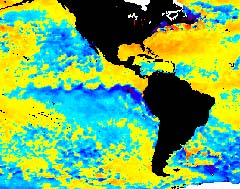| NOAA Magazine || NOAA Home Page || Previous Story |
ADIOS A EL NIÑO, HOLA A LA NIÑA
 May
19, 2003 — On the heels of El Niño’s departure the
world could soon be facing the return of La
Niña say scientists at NOAA. Based on current sea surface temperatures
and recent atmospheric and oceanic trends in the tropical Pacific, it
is likely that La Niña will develop over the next few months. (Click
NOAA satellite image for larger view of La Niña conditions present
in the tropical Pacific Ocean on May 17, 2003, which is the dark blue
area on the western coast of South of America. Please credit “NOAA.”)
May
19, 2003 — On the heels of El Niño’s departure the
world could soon be facing the return of La
Niña say scientists at NOAA. Based on current sea surface temperatures
and recent atmospheric and oceanic trends in the tropical Pacific, it
is likely that La Niña will develop over the next few months. (Click
NOAA satellite image for larger view of La Niña conditions present
in the tropical Pacific Ocean on May 17, 2003, which is the dark blue
area on the western coast of South of America. Please credit “NOAA.”)
“Once again, the value of NOAA’s robust observing systems is demonstrated in this forecast of La Niña, which will enable a wide user community to make intelligent economic decisions,” said retired Navy Vice Adm. Conrad C. Lautenbacher, Ph.D., under secretary of commerce for oceans and atmosphere and NOAA administrator.
During the last two months, sea-surface and sub-surface ocean temperatures and tropical rainfall decreased considerably across the central and eastern equatorial Pacific. By early May sea-surface temperatures were 0.5 to 1 degree C (1 to 2 degrees F) below average across the east-central equatorial Pacific. Although there is some uncertainty in the model forecasts, the dominant trend is for the cooling in the tropical Pacific to continue, and for La Niña to develop during the summer.
“Oceanic and atmospheric conditions indicate that a transition to La Niña is already underway,” said Vernon Kousky, lead El Niño/La Niña forecaster at the NOAA Climate Prediction Center. If La Niña does develop as expected, it will likely bring increased Atlantic hurricane and tropical storm activity this year. Also, it will likely bring drier and warmer-than-average conditions to the southern United States next winter. Scientists at NOAA are continuing to monitor this evolving situation very closely.
“El Niño conditions faded rapidly in the tropical Pacific during March and April of this year,” said Kousky. “The world is not presently experiencing any El Niño-related impacts.”
According to the NOAA Climate Prediction Center, La Niña refers to the periodic cooling of ocean surface temperatures in the central and east-central equatorial Pacific that occurs on average every three to five years or so. La Niña represents the cool phase of the El Niño/Southern Oscillation (ENSO) cycle, and is sometimes referred to as a Pacific cold episode. La Niña originally referred to an annual cooling of ocean waters off the west coast of Peru and Ecuador.
The ENSO Diagnostic Discussion is published monthly by the NOAA Climate Prediction Center and is a consolidated effort of NOAA and its funded institutions. The Climate Prediction Center is one of the National Centers for Environmental Prediction, which is part of the NOAA National Weather Service. The Climate Prediction Center predicts and monitors El Niño/La Niña and also produces the nation’s official long-range outlooks and medium-range weather forecasts.
NOAA is dedicated to enhancing economic security and national safety through the prediction and research of weather and climate-related events and providing environmental stewardship of the nation’s coastal and marine resources. NOAA is part of the U.S. Department of Commerce.
Relevant
Web Sites
NOAA
El Niño/Southern Oscillation (ENSO) Discussion
NOAA Climate Prediction Center
Media
Contact:
Carmeyia
Gillis, NOAA Climate Prediction
Center, (301) 763-7000 ext. 7163